The next-gen MacBook Pro with Retina Display Review
by Anand Lal Shimpi on June 23, 2012 4:14 AM EST- Posted in
- Mac
- Apple
- MacBook Pro
- Laptops
- Notebooks
The King of All Notebook Displays
For years Apple has been shipping some of the best displays in consumer notebooks, but the MacBook Pro’s Retina Display is in a league of its own. While I never liked the phrase “painted on” in reference to the iPad and iPhone Retina Displays, that’s the best way I can describe the effect the MacBook Pro’s Retina Display has on me. Text really does look painted on. The effect is really the result of two things.
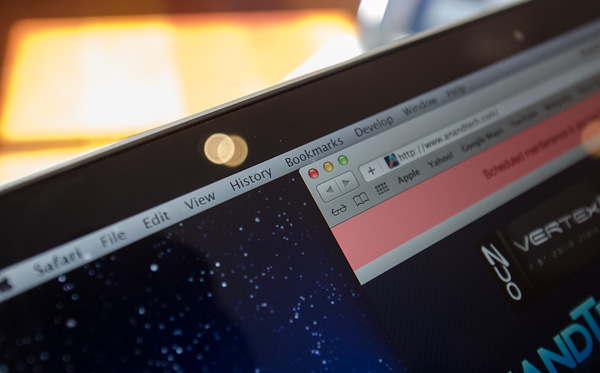
The first is Apple’s removal of its cover glass. LCD panels aren’t particularly attractive, they are ugly squares composed of two pieces of glass and a number of filters/polarizers. To hide the ugly edges, display makers wrap bezels around the display. Most people aren’t fond of bezels so next came a ton of effort to minimize bezel size. An alternative is to simply place a third piece of glass over the entire LCD assembly and make it look as if the bezel and LCD panel are integrated. This outermost layer is known as a cover glass and is what Apple uses on all of its glossy displays. If you’ve ever taken apart a Cinema/Thunderbolt Display or a newer iMac you’ll know that the cover glass is literally just a piece of glass that you have to remove with some suction cups.
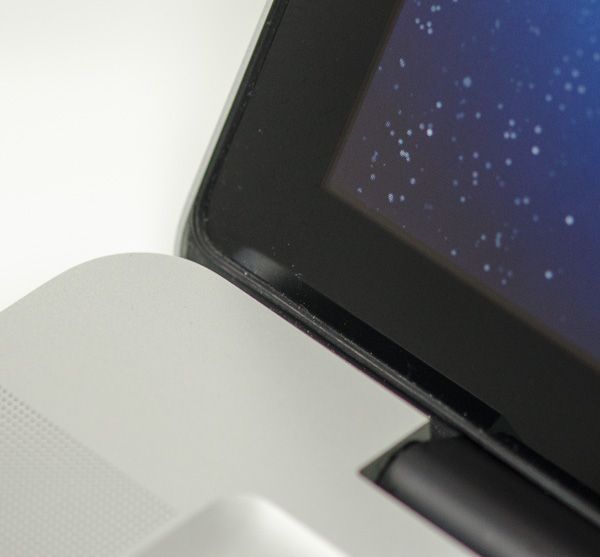
Non-Retina MacBook Pro, notice the gap between the outermost LCD glass and the cover glass
The MacBook Pro’s Retina Display does away with the cover glass and instead uses a fairly unique LCD assembly. There are still two pieces of glass but the outermost glass is actually a different size and shape - it integrates a bezel. By integrating the bezel into the outermost glass in the LCD stack you get the same effect as a cover glass but without the added reflections it introduces.
You also limit the possibility of dust getting trapped between the cover glass and the LCD. The danger is that you no longer have a protective piece of glass in front of your expensive new LCD. If you scratch the display you're scratching the LCD itself. While this has been true for conventional matte displays for a while, it's worth mentioning if you're used to Apple's glossy displays where you did have that added security layer.
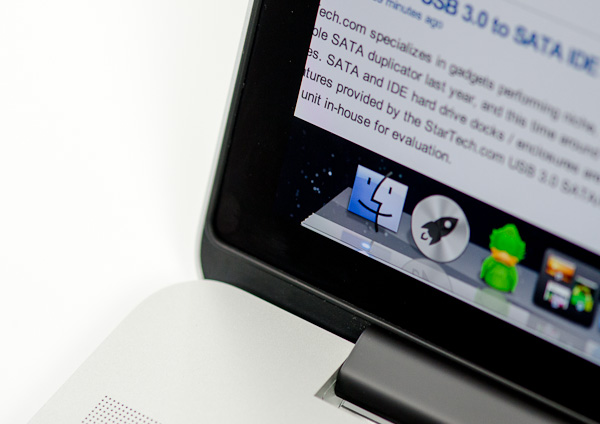
The MacBook Pro with Retina Display, no gap, no cover glass
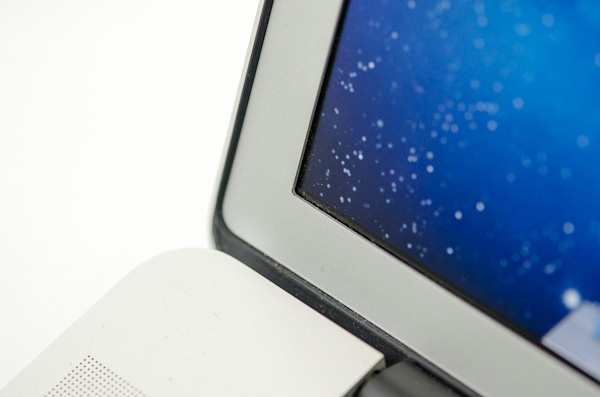
The 2011 MacBook Pro with High-Res Matte display option, no cover glass, top bezel

From left to right: 2010 High Res Glossy MBP, 2012 rMBP, 2011 High Res Matte MBP
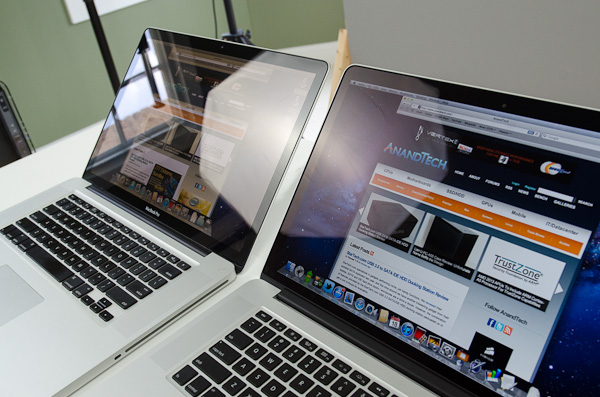
Glare handling indoors - 2011 High Res, Glossy MBP (left) vs 2012 rMBP (right)
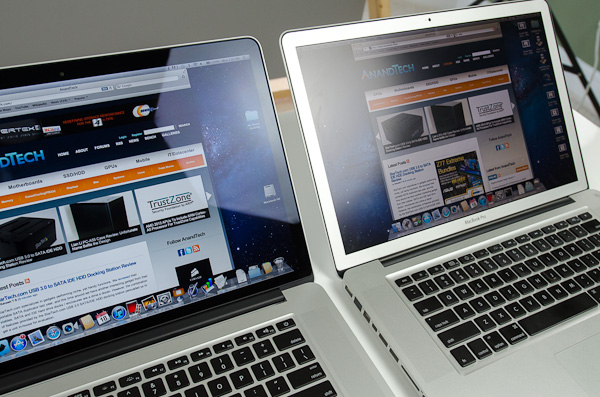
Glare handling indoors - 2012 rMBP (left) vs. 2011 High Res, Matte MBP (right)
The Retina Display is also obviously an extremely high resolution panel at 2880 x 1800. Note that this is 44.6% more pixels than Apple’s 27-inch Thunderbolt Display, and 26.6% more pixels than the 30-inch panels that we’ve loved for so long - all in a 15.4-inch notebook display.
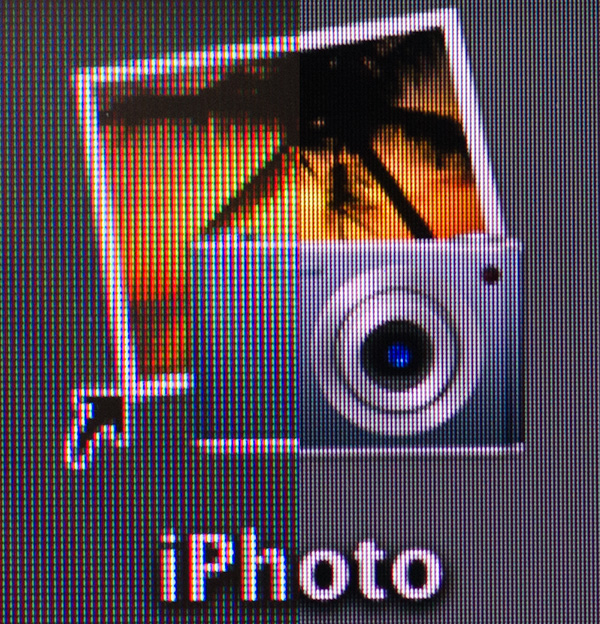
An iPhoto shortcut, High Res 2011 MBP (left) vs. Retina Display MBP (right)
At 220 pixels per inch it’s easily the highest density consumer notebook panel shipping today. At normal viewing distances and even with my face closer than I’m comfortable putting it I simply cannot discern individual pixels.
It’s the combination of these two elements, the removal of the cover glass and the insanely high pixel density that makes everything from text to UI elements just look painted on the new Retina Display. And the effect is gorgeous. I’ve never seen a prettier panel and it’s actually ruined me for pretty much all other displays, notebook and desktop.
While I can appreciate the iPad’s Retina Display, the impact from the MacBook Pro’s display is even more significant. Perhaps it’s because I still spend so much time working on a standard, non-tablet display, but I’m far more excited about this display than anything else Apple has delivered under the Retina moniker.
It’s not just pixel density that Apple has to offer here. Similar to its Retina Displays in the iPhone and iPad, the MacBook Pro’s Retina panel ditches TN in favor of IPS technology. The result is an incredible improvement in viewing angles. On a notebook I don’t spend a lot of time viewing it from far left/right angles, although I see the benefit when I’ve got others huddled around my display. Here the panel performs admirably - you lose brightness at far left/right angles but there’s no perceivable color shift. In fact, the painted on effect is even more impressive at these far left/right viewing angles.
For a single user however the more impressive characteristic is just how good the display looks at vertically off-center angles. I wrote much of the initial parts of this review while on an airplane in coach, which with a 15-inch notebook on my lap means I’m going to be looking at the display at a weird angle to begin with. The thinner rMBP doesn’t do enough to make the airplane usage model any better if the person in front of you decides to recline, but the IPS panel does make the display perfectly usable at the off-center angle you’ll inevitably have to deal with.
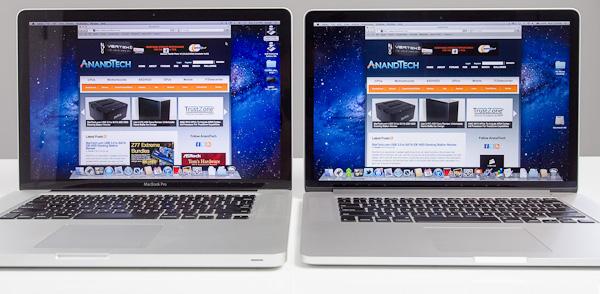
2010 High Res, Glossy MBP (left) vs. 2012 rMBP (right)
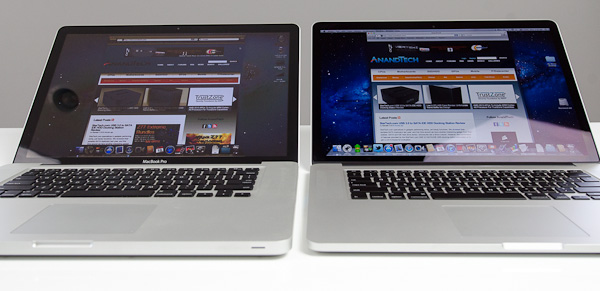
Hello colorshift!
2010 High Res, Glossy MBP (left) vs. 2012 rMBP (right)


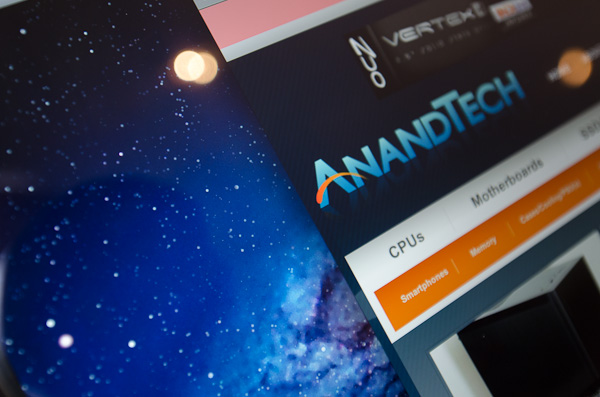
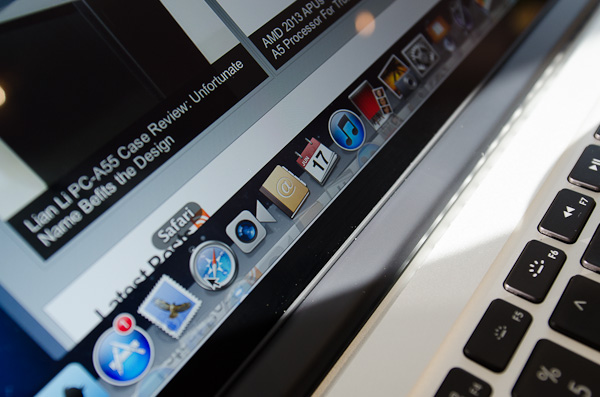
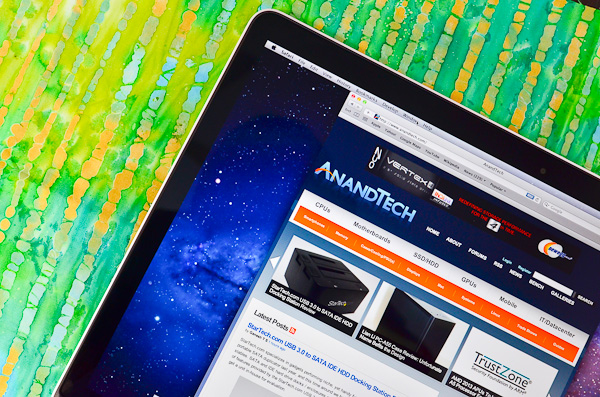
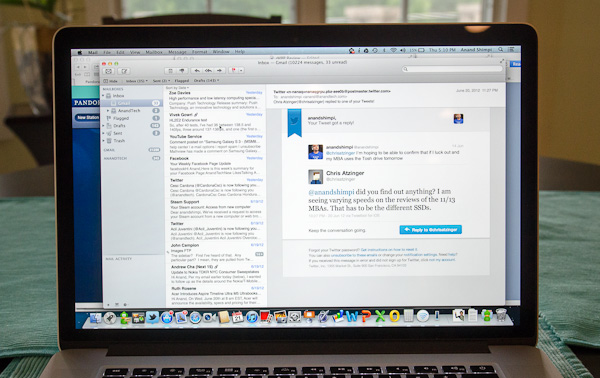
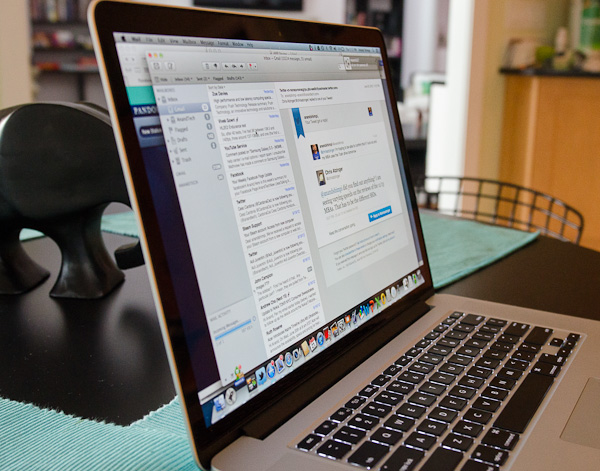








471 Comments
View All Comments
wendoman - Saturday, June 23, 2012 - link
Coming soon as usual.I've been using QuickSync fast encoding for free for over a year.
Spoony - Saturday, June 23, 2012 - link
That's really great for you. Fast encoding with QuickSync is nice. I've used it too, and wished it would get OS X support. Happy to see that is is now.Side note, all of the Windows-based encoders that execute QuickSync use an application-internal package. OS X will be implementing this at the system level, all software today that asks for an encode from QTKit should get it handed off to the fixed-function encoder. It's a much nicer solution, in my opinion.
AnotherNetNarcissist - Saturday, June 23, 2012 - link
Well done. Your medal is in the post.Taft12 - Monday, June 25, 2012 - link
That makes you and Anand who seem to care. We're up to two! I've yet to meet anyone else that does.iCrunch - Saturday, June 23, 2012 - link
...for an amazingly detailed review! This is what I had been waiting for, but nobody else comes even close to the technical knowledge and its applications.I have the "entry-level" rMBP (2.3GHz/8GB/256GB "SSD" NAND Flash) and the first thing I did was to remove Lion and install Mountain Lion DP4 with its thus far single major update. No UI elements ever flashed on me and everything seems to render just right in Safari 6 as well as throughout ML's UI elements and text. That's in both the "Ideal" Retina mode as well as WSXGA+ (1680x1050) and WUXGA (1920x1200). In the latter two modi, everything is just smaller, as you'd expect, but I find that under ML and Safari, it looks (virtually) as good as in "Retina" mode (1440x900).
Have you found any evidence of WUXGA icons in native resolution, for example, as a possible explanation as to why it scales so unbelievably well? I was truly hoping for a second native resolution for SXGA+, which would have entailed an even higher (3360x2100) native resolution, but as I'm typing this in WUXGA, in the highest of the 5 resolution modes, I find everything to appear as though it were native resolution. The crispness of text and images/icons throughout OS X 10.8 ML as well as the absurdly fast Safari 6, or is it all scaling, almost disproving the rule that any display's native (=highest) resolution works best?
As for the SSD, co-incidentally, I had two 180GB Intel 520 Series SSD's in my now former Late-2011 antiglare 17" MBP. I was happy to read through tons and tons of benchmarks spread throughout various articles right here on Anandtech, and even happier to find out that the Samsung 830 Flash that's in my Retina MBP (the 256GB version) and the Intel 520 (180GB) that I had before seemed to be highly comparable in virtually all categories. I am thinking about getting the 2.6 version with the 512GB Flash, but as seems to be the case with the 480GB Intel 520 Series, the 1/2 TB SSD's seem to be a tad slower than those in the 240/256GB range. Any ideas as to why?
IKeelU - Saturday, June 23, 2012 - link
I believe calling this a "revolution in computing" is hyperbole. I/O is evolving, as it always has. Computer density is increasing, as it always has. If anything, the new Mac Pro demonstrates that much improvement can be had in the device itself. It's not just a matter of improving connectivity to more capable devices.DeciusStrabo - Saturday, June 23, 2012 - link
I agree, but in the last few years we saw a backslide in screen resolutions on mobile devices. We had 1920x1200, IPS years ago. Suddenly we got 1366x768, TN, glare on the large majority of laptops. So the change to larger resolutions again (not only Apple, others too have started to include 1080p screens with their laptops as mainstream option).But generally you're correct. We moved from 1024x768 on 15-17" screens everywhere to 27" 2560x1440 IPS being available for as low as 600 USD. Over the next 2-3 years 4k displays will become mainstream for TVs. Technology is moving on, Apple is just one to seize if first here.
solipsism - Saturday, June 23, 2012 - link
Why is 1080p being compared to this display? Even the display in the iPad being powered by a mobile iGPU far exceeds that of 1080p.DeciusStrabo - Saturday, June 23, 2012 - link
Because it is the mainstream option available to laptops outside of one single one (and some old ones like the T61)?dagamer34 - Sunday, June 24, 2012 - link
The iPad doesn't have to deal with a window layering system which greatly reduces the amount of overdraw it has to deal with.